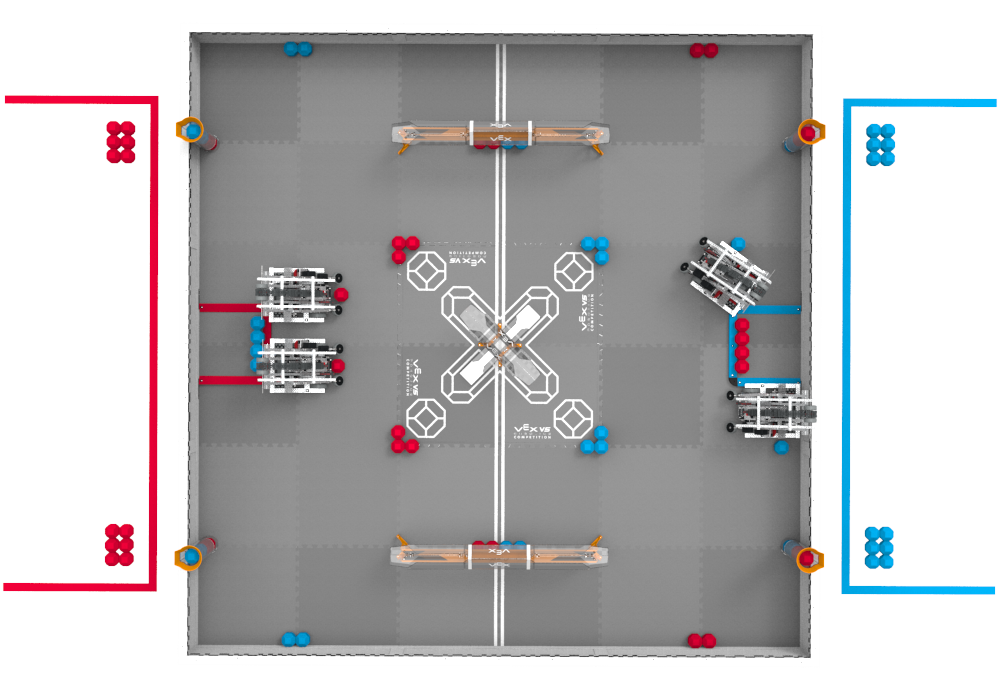Session 7: Specific Game Rules
These are the 11 rules that are specific to how you play Push Back.
<SG1> Starting a match
At the start of each match, alliance robots must be no larger than 18″ long x 18″ wide x 18″ tall. They must be placed contacting the alliance parking zone barrier. A robot cannot be touching blocks (other than 1 preload), goals, loaders, or its alliance partner robot.

<SG2> Horizontal expansion is limited
Once the match begins, robots can expand beyond the 18″ x 18″ starting size, but it can never be larger than 22″ wide or 22″ long. (The robot must always be able to fit inside a 22″ x 22″ square.
<SG3> Vertical expansion is limited
The robots must begin each match with dimensions smaller than 18″ x 18″ x 18″. Once the match starts, robots may expand vertically as long as they don’t exceed an overall height of 22″ at any point in the match.
<SG4> Keep scoring objects in the field
You may not intentionally or strategically remove blocks from the field. If a block does leave the field during a match (intentionally or unintentionally), it will be given to a drive team member from the same color alliance as the block and it can be used as a match load.
Any team who removes 3 or more blocks from the field in a single match will immediately receive a major violation (disqualification).
<SG5> Each robot gets one block as a preload
Prior to the start of each match, teams may each place one preload block (of the same color as their alliance) so that it:
- touches only one robot of their alliance
- does not touch the same robot as another preload
- is not touching or within a goal or loader
<SG6> Robots may possess an unlimited number of blocks
A robot can carry, push, or plow an unlimited number of blocks. Horizontal and vertical expansion limits still apply to all parts of the robot for the entire match.
<SG7> Don't cross the autonomous line (during the autonomous period)
Robots cannot cross the autonomous line (the double white tape line running across the middle of the field) during the autonomous period. This means you cannot touch the foam tiles, blocks, or field elements on the opposing alliance’s side of the line. Intentionally disrupting an opponent’s blocks or field elements, or contacting the opponent’s robot will result in violations…
<SG8> Engage with the autonomous line at your own risk
Teams are responsible for the actions of their robots at all times. During the autonomous period, when opposing robots are both engaged with the same block, you should expect robot-on-robot interactions. If damage, entanglement, or tipping over occurs, the head referee will determine if an intentional <GG14> violation (don’t destroy other robots) has occurred (as would be done the driver controlled period). Incidental violations of <SG7> (don’t cross the autonomous line) due to interaction with the same block will not be penalized. Intentional, strategic, repeated, or egregious offenses (like interfering with a robot that is not engaging the autonomous line) may be deemed a violation by the head referee.
<SG9> Match loads may be introduced during the match
While introducing blocks into the loader, a drive team member’s hand can temporarily break the plane of the field perimeter. Blocks can be placed into either of the loaders on your alliance station side and only during the diver controlled period of a match. Match load blocks cannot be touched by a robot before being placed into the loader, and can only be removed from the loader by a robot through the bottom opening of the loader. If a block unintentionally bounces out of a loader while being loaded, it is not a violation. Excessive, unnecessary, or unsafe actions while introducing blocks can be considered violations.
<SG10> Don't reach inside enclosed sections of the goals
Robots cannot touch blocks that are fully within the enclosed sections of long goals. They can add or remove blocks from the open sections of goals at any time.
<SG11> Park Zones are protected during the endgame
You cannot touch an opponent’s park zone or opponent robots parked in that zone during the last 20 seconds of the match. Intentional, strategic, or egregious violations will be considered major violations (disqualification).
Assignment:
Go to the V5RC Drive Team Training Course and complete the Unit 5 Quiz.
If you miss any of the questions, now is the time to figure out why. Look back through the rules and the information listed in this session for clarification.
